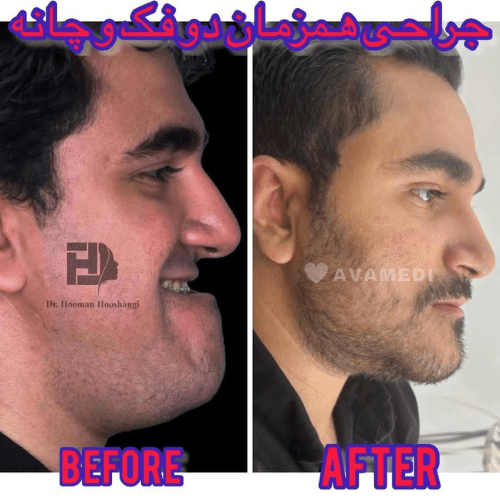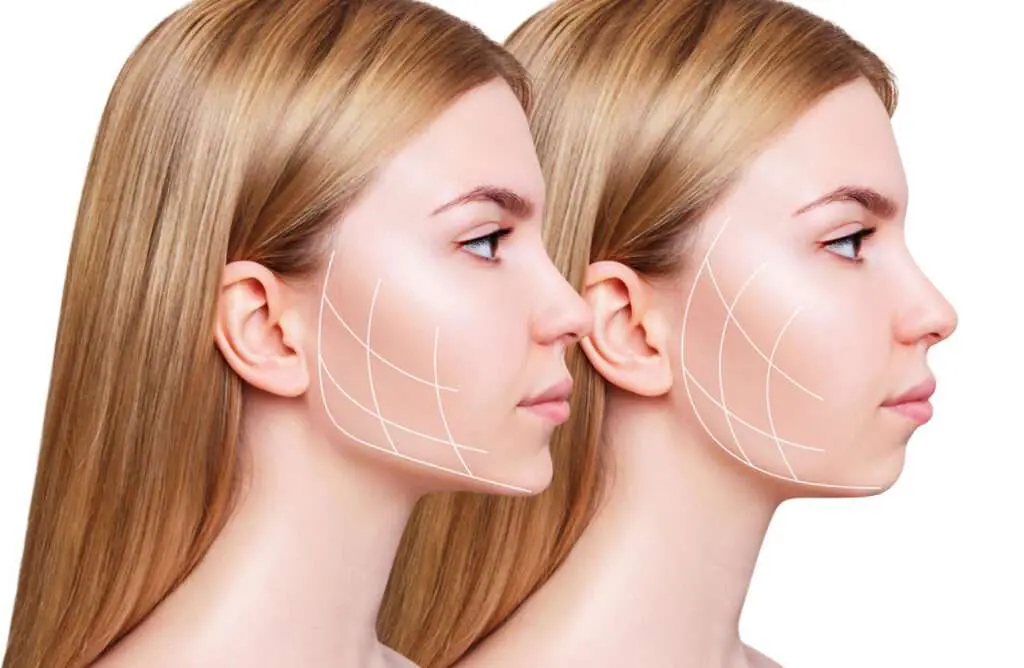What is jawline surgery?
Jawline surgery, or jawline enhancement surgery, can reshape the jaw and chin area. It can be used to enhance and define the jawline or reduce the bone size to give the chin a slimmer appearance. In some cases, Jawline surgery can also be employed to realign teeth and the jaw if they are not functioning properly.
This surgical procedure reshapes the chin and jawbone to enhance the jawline’s appearance. It’s also known as V-line surgery because it creates a more defined and angular jawline, resembling the shape of the letter “V.”
If you’re dissatisfied with the appearance of your jaw, experiencing pain related to temporomandibular joint disorder (TMJ), or unhappy with the appearance of Botox along the jawline, you may be a good candidate for jawline surgery.
During the jawline enhancement surgery, a skilled facial plastic surgeon will carefully remove excess bone from the jaw and chin to create a more aesthetically pleasing shape. The procedure may also involve adding or removing volume to the jawline depending on the patient’s needs.
If you haven’t fully grown yet, it’s important to wait before considering this procedure as the jaw can change with growth.
Who is a good candidate for jawline surgery?
Jawline surgery is suitable for individuals dissatisfied with the shape or size of their jawline, and it is an option for both men and women of any age who are in good general health. Ideal candidates for jawline enhancement typically have a weak or undefined jawline, an asymmetrical jaw, or an overly prominent jawline that disrupts the facial balance. If you’re unsure if you’re a suitable candidate for jawline surgery, a comprehensive evaluation during a consultation can help determine if this is the right choice for you.
Various issues can be addressed through corrective jaw surgery, including:
- Bruxism (teeth grinding)
- Temporomandibular joint disorders
- Sleep apnea
- Chewing problems
- Speech impediments
- Facial alignment irregularities
- Jaw prominence.
The best candidates for this type of facial surgery are individuals dealing with any of the mentioned problems and who are not ideal candidates for various non-surgical treatments. These patients should generally be in good health and have realistic expectations about the surgery and what it can achieve. It’s also crucial for patients to meticulously follow post-surgery care instructions to minimize the risk of complications and adverse side effects.
Is Jawline surgery suitable for me?
In many cases, Jawline surgery is an excellent option for people suffering from temporomandibular joint disorders, sleep apnea, and other jaw joint problems. However, ideally, jawline enhancement should only be used when less invasive treatments are ineffective or impractical due to the nature of the patient’s jaw issue. For example, orthodontic treatment can sometimes alleviate jaw problems in some patients without the need for corrective jaw surgery.
How does Jawline surgery work?
Typically, jawline surgery is performed intraorally, ensuring there are no visible facial scars on your chin or jaw. However, in some cases, small incisions outside the mouth may be necessary.
The jawline surgery involves the surgeon making precise incisions in the jawbones and repositioning them correctly. After the jaw realignment, small bone plates, screws, wires, and rubber bands are utilized to secure the bones in their new positions. Over time, these screws, which are smaller than those used in orthodontics, become seamlessly integrated into the bone structure.
In certain instances, additional bone may need to be added to the jaw during jawline enhancement. This involves the transfer of bone from the hip, leg, or rib, which is then secured in place with plates and screws. Alternatively, bone reshaping may be performed to ensure a better fit and harmony with the rest of the facial features.
Jawline surgery can address concerns in the upper jaw, lower jaw, chin, or a combination of these areas.
- Upper Jaw (Maxillary Osteotomy):
This Surgery on the upper jaw is employed to correct various issues such as:
- Overly retruded or excessively protruded upper jaw
- Underbite
- Excessive or insufficient tooth display
- Open bite
- Mid-face deficiency (mid-face hypoplasia)
During this procedure, the surgeon makes precise cuts above the teeth, allowing the entire upper jaw, including the roof of your mouth and upper teeth, to move as a single unit. The upper jaw and upper teeth are then repositioned forward to achieve proper alignment with the lower teeth. This planning often involves the use of computer-based tools to determine if further treatments, such as orthodontics, are necessary to address any remaining discrepancies. An open bite, characterized by excessive bone growth above the teeth, causing a flat and slanted surface, can also be corrected by shaving or removing the excess bone. Bone plates and screws are employed to secure the repositioned jawbone.
- Lower Jaw (Mandibular Osteotomy)
This Surgery involving the lower jaw can rectify issues like:
- Retruded lower jaw
- Protruded lower jaw
In this procedure, the surgeon makes cuts behind the molars and lengthwise along the lower jaw bone, enabling the front part of the jaw to move as a single unit. The jaw is then repositioned, either forward or backward, to its new alignment. Plates and screws are used to maintain the stability of the jawbone during the healing process.
- Chin Surgery (Genioplasty)
Chin surgery, or Genioplasty often performed concurrently with jaw surgery, can correct a small or deficient chin, which is frequently associated with a severely retruded lower jaw. The surgeon reshapes the jaw and adjusts the chin during the same surgery. A portion of the chin bone is cut at the front of the jaw, moved forward, and secured in its new position using plates and screws.
Post-Procedure Care for Jawline Surgery:
Following the jawline enhancement surgery, your doctor will provide you with post-operative instructions, including guidance on:
- Dietary restrictions
- Oral hygiene
- Avoiding tobacco use
- Restraining from strenuous activities
- Pain management medications
- Timing for returning to work or school, typically within one to three weeks
Initial recovery after jawline surgery generally takes approximately six weeks, but complete recovery may extend up to 12 weeks. Around six weeks post-surgery, an orthodontist will complete tooth alignment using braces, if necessary. The entire orthodontic process, inclusive of surgery and braces, may span several years. Once the braces are removed, retainers can be utilized to maintain the proper alignment of your teeth.













